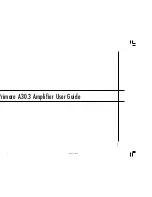
Manual-3
REAR PANEL DESCRIPTION
MAIN OUTPUTS—MIC-level:
Two XLR connectors used as a direct feed to mixing console mic inputs. Pin 2 is “+”
positive, pin 3 is “–” negative, and pin 1 is signal ground.
MAIN OUTPUTS—LINE-level:
Two ¼" TRS (Tip-Ring-Sleeve) connectors deliver the Main A & B Line Level Outputs.
No surprises here: the tip is “+” positive, the ring is “–” negative and the sleeve is signal ground.
MAIN OUTPUTS MONO button:
Engaging this pushbutton combines (or Monoes) the Main A & B Output.
EXPAND IN A & B jacks:
Two unbalanced ¼" TS jacks used to expand the SP 13. These Inputs sum (pre-Main Level
control) with the Main A & B signals. Mono expansion is done using
only
the EXPAND IN A jack. As long as nothing is
plugged into the B jack, the signal from EXPAND A automatically drives EXPAND B. These jacks also provide an auxiliary
input path from another mixer, instrument, tape, etc.
INSERT loop A & B jacks:
Two unbalanced ¼" TRS jacks wired per the tip=send, ring=return convention. Allows placing
an outboard signal processor in series with the main signal paths.
RETURN A & B jacks:
Two unbalanced ¼" TS jacks used as the return path from the OUTPUTS of an outboard signal
processor. Mono signals use
only
the RETURN A jack. As long as nothing is plugged into the B jack, the signal from
RETURN A automatically drives RETURN B.
SEND A & B jacks:
Two unbalanced ¼" TS jacks are used to connect to the
inputs
of an outboard signal processor. Mono
effects units should wire
only
to the SEND A jack.
AUX OUTPUT:
An unbalanced ¼" TS jack gives a direct dry Output signal from the A Pickup only. The PICKUP A OUT
slider controls the amount of signal.
TUNER OUTPUT:
An unbalanced ¼" TS jack used for tuner connection, fed by both pickups. Located post EQ but pre-
LEVEL, this Output is unaffected by either the LEVEL or OUT controls. For convenience, the tuner may be left connected
during performances.
Ground lift switch:
provides the ability to separate chassis ground and signal ground. Normally, this switch should be in
the “grounded” position. In some circumstances, moving it to the opposite position eliminates hum and buzz problems.
Remote power supply input:
This unit is supplied with an RS 1 Remote AC Power Supply (RAP) suitable for connection
to this input jack. The power requirements call for an 18 VAC center-tapped transformer.
This is not a telephone jack. Never
use a power supply other that the one supplied or a replacement approved by Rane.
Using any other type of supply may
damage the unit and void the warranty.
Chassis grounding screw:
A #6-32 screw is used for chassis grounding purposes. See CHASSIS GROUNDING below.
CHASSIS GROUNDING NOTE
If after hooking up your system it exhibits excessive hum or buzzing, there is an incompatibility in the grounding
configuration between units somewhere. Here are some things to try:
1. Try combinations of lifting grounds on units that are supplied with ground lift switches or links.
2. If your equipment is in a rack, verify that all chassis are tied to a good earth ground, either through the line cord
grounding pin or the rack screws to another grounded chassis.
3. Units with outboard power supplies do not ground their chassis through the line cord. Make sure that these units are
grounded either to another chassis which is earth grounded (such as the amplifier), or directly to the grounding screw on an
AC outlet cover.
Please refer to RaneNote 110, “Sound System Interconection” (included with this manual) for further information on
system grounding.






















